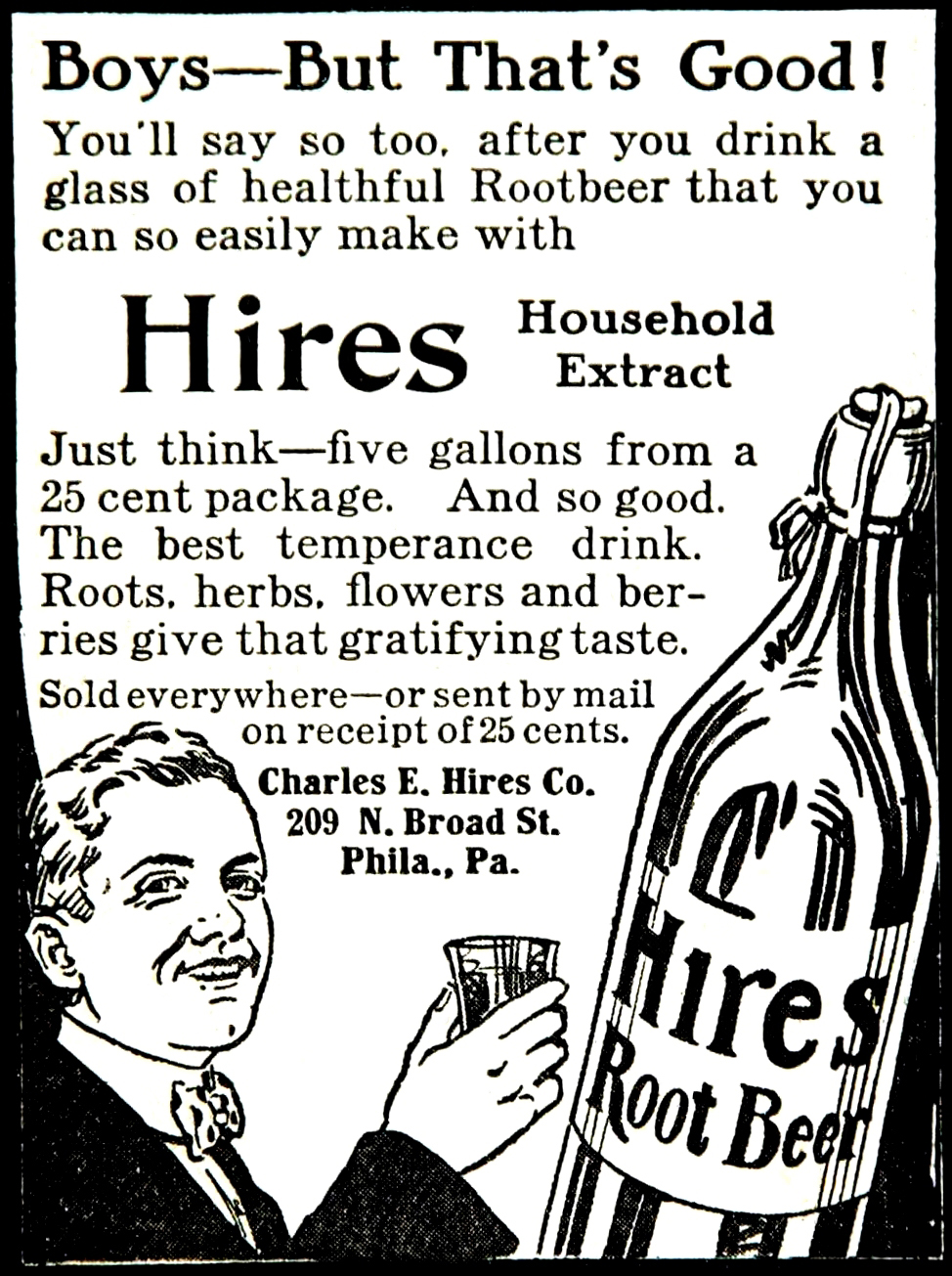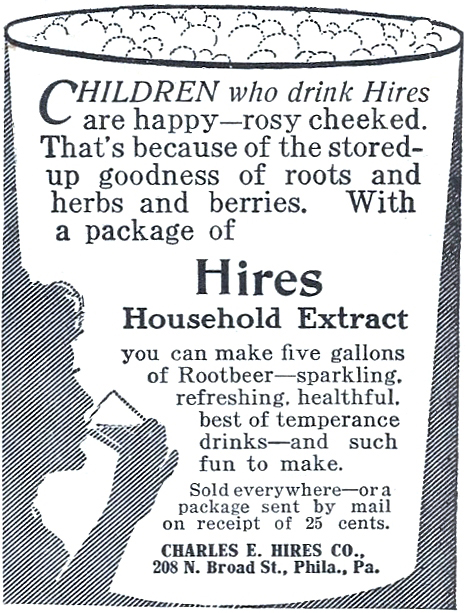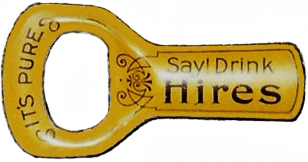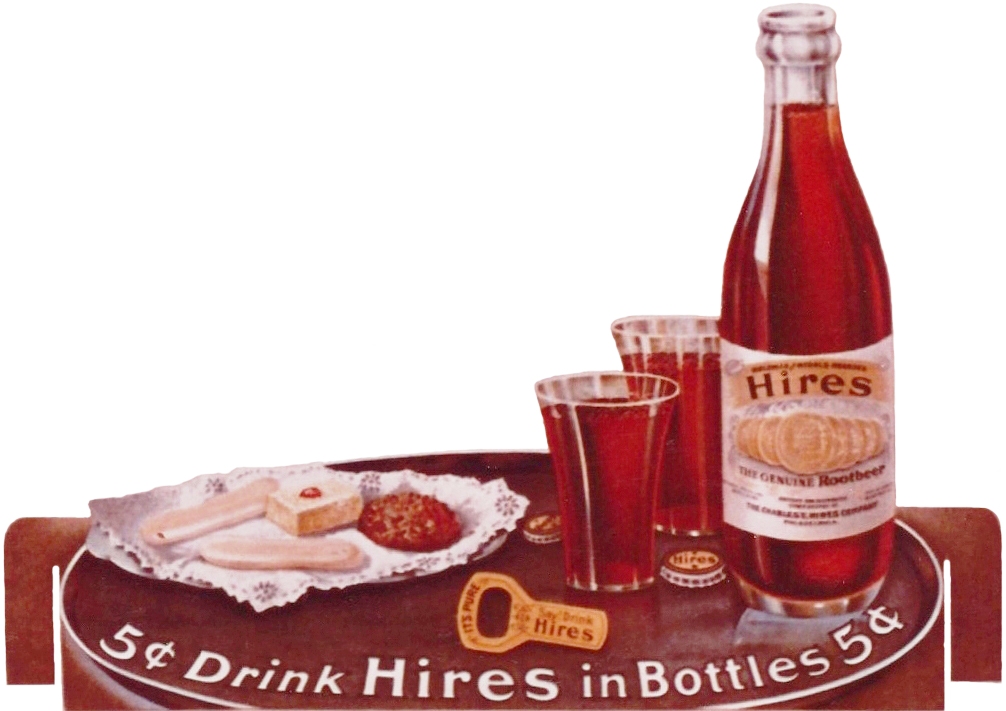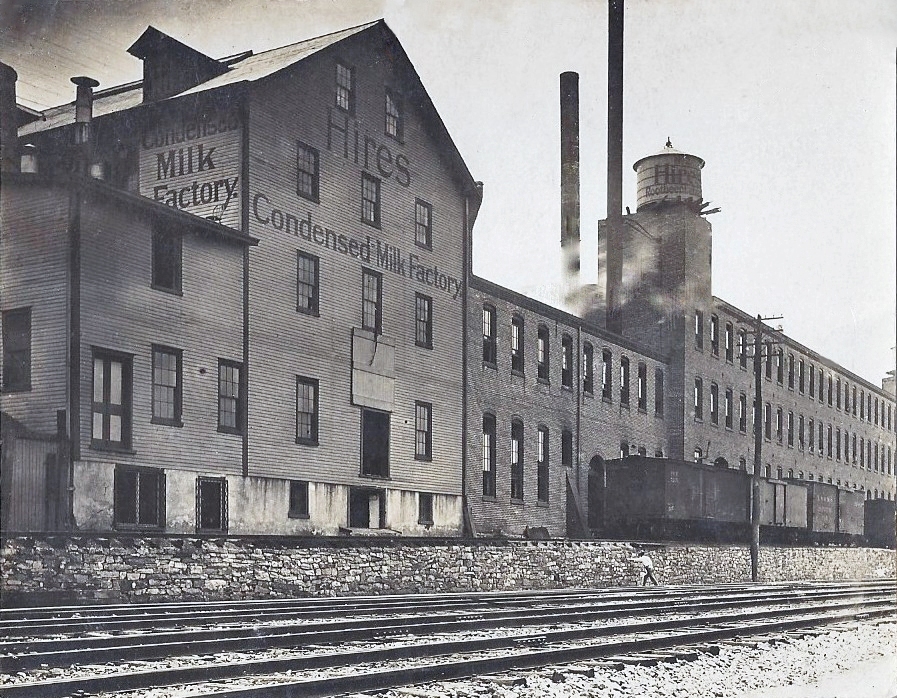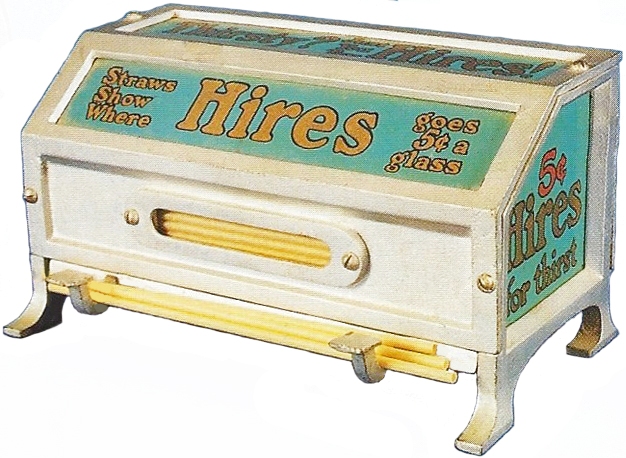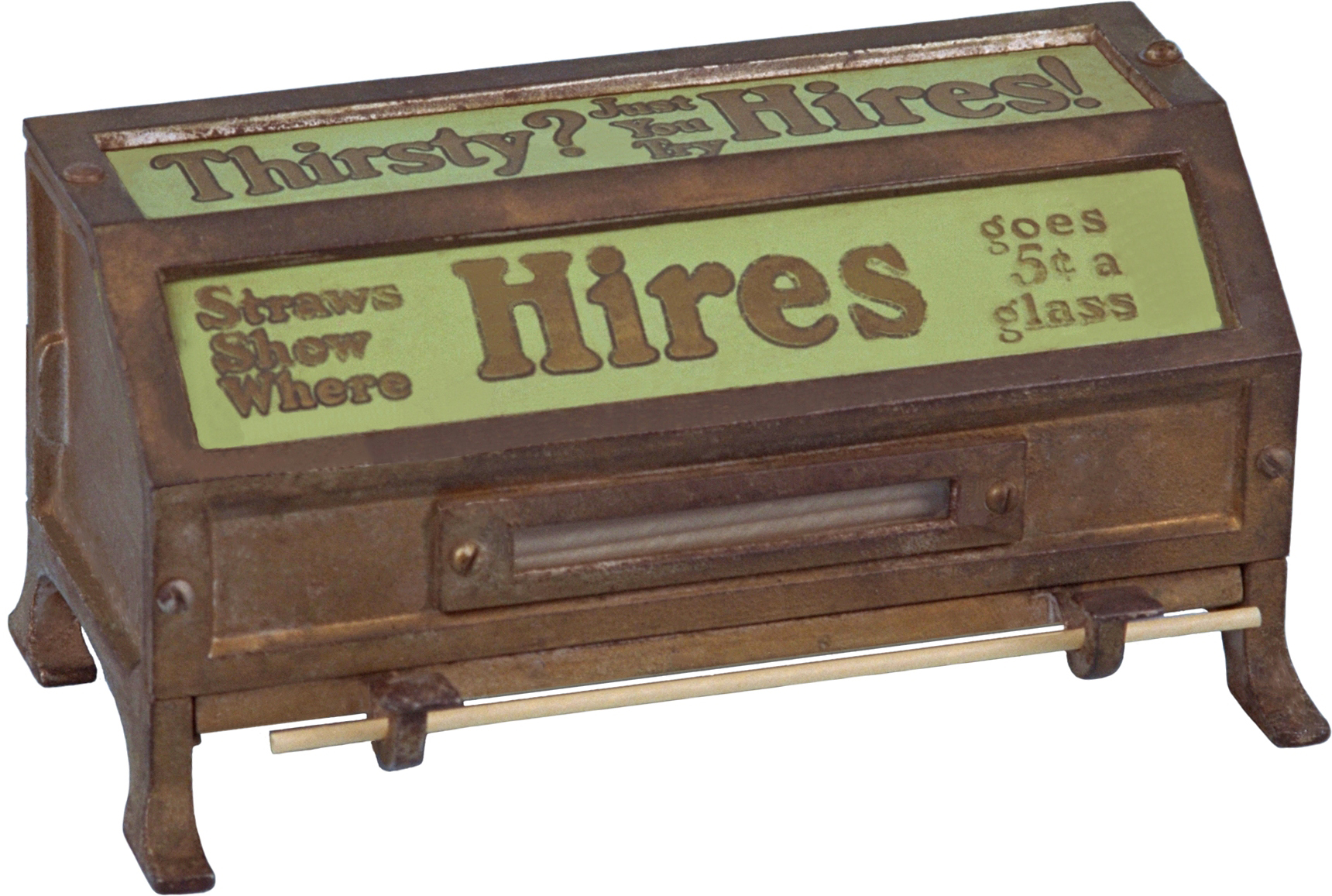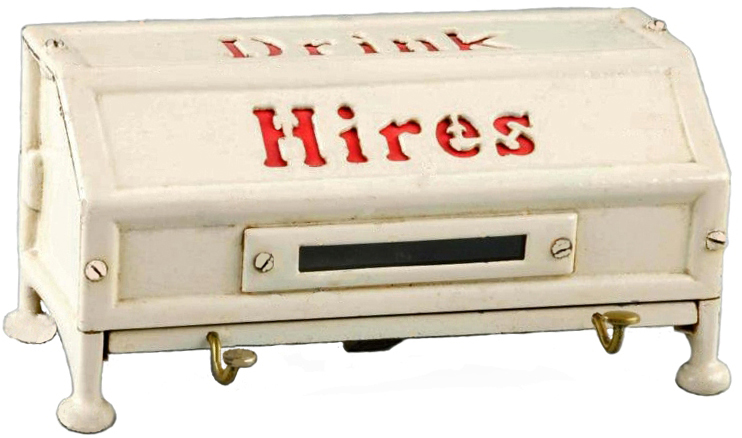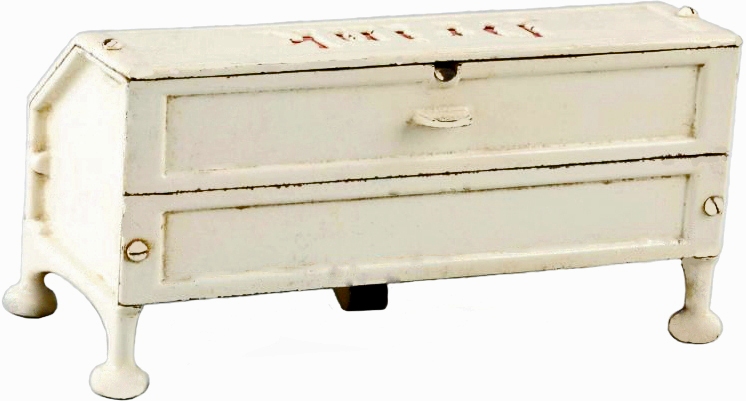1911
IT HAPPENED IN…1911
A fire at Triangle Waist Company, a New York City
garment factory, trapped 850 workers due to locked exits.
Most of the 146 victims were 16-23 year old Italian and
Jewish immigrant women.
Ray Harroun won the first Indianapolis 500 auto
race at an average speed of 74.59 mph.
Calbraith P. Rodgers flew a biplane from New York
to California in 82 hours and 4 minutes.
(Figure
1911-01, The
Youth’s Companion, May 18 and July 11, 1911)
These two magazine advertisements ran at the same
time.
(Figure 1911-02, magazine
advertisement, June 5, 1911)
(Figure 1911-03, magazine
advertisement)
(Figure 1911-03.5, Chicago
Daily News, July 3, 1911)
The front and back of this clear, automatic bottle machine-made crown top bottle are embossed “Hires” on the sides near the base, with embossed gold medals around the shoulders. The bottle’s capacity was 14 fluid ounces.
(Figure 1911-04, clear, ABM crown top, 9.5”
tall)
This Hires bottle opener was patented September 18,
1911.
(Figure 1911-05, bottle opener, 3.0” x 2.0”)
When the two sections of this die-cut, cardboard
counter or window display are fit together, the attractive young lady
appears to be holding a serving tray bearing a full bottle of Hires
Rootbeer, two full glasses, two crown caps, a yellow 1911 bottle opener,
and a small tray containing an assortment of cookies.
(Figure 1911-06, two-piece,
die-cut, cardboard counter or window display)
This postcard pictures Hires’ Condensed Milk Factory
in Lake Odessa, Michigan.
(Figure 1911-07, real photo
postcard, postmarked October 6, 1911)
The lithographed advertising wording on this cast
iron straw dispenser reads: “Thirsty? Just You Drink Hires!;” “Straws
Show Where Hires goes 5¢ a glass;” and “5¢ Hires for thirst.”
It measures 10.0" wide, 6.0" high, and 5.0" deep.
The remaining supply of straws is visible through the window on
the front.
(Figure 1911-08, cast iron
straw dispenser, white)
This example of the same style dispenser wasn't painted.
(Figure 1911-08, cast iron
straw dispenser, unpainted)
This cast iron straw dispenser was patented October 24, 1911. The words “Drink Hires” are cut-out with a red background. It measures 9.625" wide, 4.875" high, and 4.25" deep.
(Figure 1911-09, cast iron
straw dispenser, front)
(Figure 1911-09, cast iron
straw dispenser, back)
The January 15, 1912 issue of
The American Bottler magazine
included this news item:
Charles E. Hires Weds
Charles E. Hires, the root beer manufacturer, who
lives at Haverford, Pa., was married on December 29th to Miss
Emma Waln, at the home of the bride’s aunt, Mrs. Robert J. Kirby, 1202
Spruce Street, Philadelphia.
Both are members of the Society of Friends, and the ceremony was
exceedingly simple, members of the two families being the only
attendants.
Miss Waln is a direct descendant of Nicholas Waln,
who came here with William Penn on the good ship
Welcome.
Her family has figured prominently in the history of Philadelphia
since its foundation.
According to a
Main Line Times web site article authored by Kathy O’Loughlin in
2010:
Hires’ personal life presented him with great
happiness but also terrible sadness…After 35 years of marriage, Clara
died and Charles went through “an agonizing period of grief.” He later
married Emma Waln, a member of a prominent old Quaker family who had
been a teacher at Friends’ Central School.
There she was known as “Miss E” and had been the teacher for
Hires’ daughter, Linda…
The family lived in Rose Hill on a 20-acre park-like
site on Highland and Montgomery avenues in Merion.
The estate is now the site of Temple Adath Israel…
Hires also had many grandchildren, including William
Hires (Harrison Streeter’s son) who wrote a short remembrance of his
family for The First 300.
“Grandfather was very much in sympathy with Quakers, but he
didn’t sign up as a Quaker until he remarried Emma.”
I started my school career at Friends’ Central in third grade and
Grandfather was one of the people instrumental in having it move out to
City Avenue, the old Morris house,” said William Hires.
Talking about the family business, William Hires
said, “Grandfather had started the business back in the 1870s.
My father was in the root-beer business too. I remember he told
me that his first job was summer employment.
I worked one summer, after I was in first year of Montgomery
School, and Father said, ‘Now I’m starting you off at $12 a week.
My father started me off at $8 a week.’
In those days — this was 1936 — you worked half a day on Saturday
too. There was this line of
bottles that kept coming toward me on a moving platform, a metal
conveyor belt. And right in
front of me would be boxes coming along, and I’d take two bottles out
and put them in, and when you filled the box you pushed the box on, and
another box would come into place.
All day long. Someone
said, ‘Treat this guy just like anybody else, and forget about the fact
that his name is Hires.’ I
remember being called to task at lunchtime because I was so exhausted I
would lie down whenever I could at lunchtime.
They said, ‘You don’t want to do that.
That’s not setting a good example.
You want to get out there and play baseball with the other guys.’
I worked for the Hires Company for a year after a year at
Harvard.”

